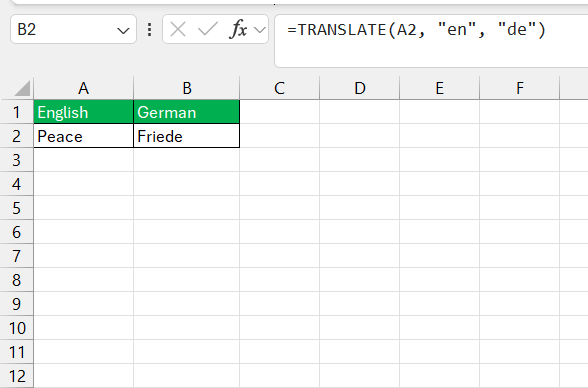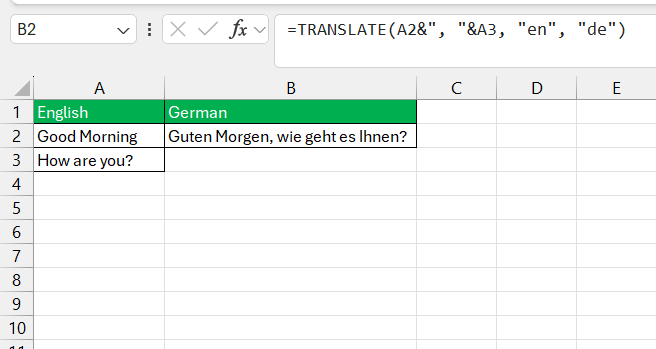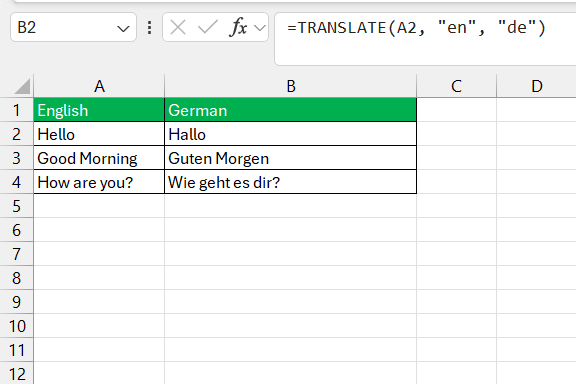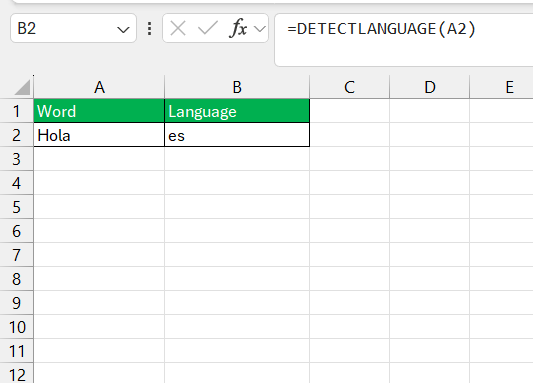Microsoft Excel is widely used for data analysis, financial modeling, and numerous other applications. Over the years, Excel has evolved to include a variety of functions that make it not just a spreadsheet application but a comprehensive data management tool. Among the newer and more exciting functions are the Translate and DetectLanguage functions, which enable users to handle multilingual data more efficiently.
Key Takeaways:
- Excel’s Translate function allows users to translate text between different languages directly within spreadsheets, breaking down language barriers for seamless global communication.
- The DetectLanguage function in Excel automatically identifies the language of the provided text, making it easy to categorize and analyze multilingual data.
- These functions are invaluable for multinational businesses, educational purposes, and market research, enabling efficient handling and analysis of international data.
- Using cell references, combining with other Excel functions, and creating dedicated translation tables can enhance the efficiency and accuracy of translations.
- Ensuring a stable internet connection, using correct language codes, providing clear and sufficient text, and double-checking translations can overcome common issues and improve accuracy.
Table of Contents
Unveiling the Language Tools in Excel
The Power of Translate Function
Imagine seamlessly conversing with people from around the world, with no language barriers limiting your reach. With Excel’s TRANSLATE function, this is no longer just a daydream for multilingual communication. Challenge the confines of language in your spreadsheets by utilizing the TRANSLATE function.
By offering a simple yet effective way to render your text into a plethora of languages, it empowers multinational brands and foreign students alike. Imagine typing “Bonjour” and within moments, witnessing it transform into “Hello”—that’s the magic of translation in Excel at your fingertips.
DetectLanguage: Breaking Language Barriers
By introducing you to DETECTLANGUAGE, Excel breaks down linguistic barriers that once seemed impenetrable. This exceptional tool acts as your very own linguistic detective, sneaking into passages and phrases to unravel the mystery of the language used.
If your spreadsheet is blossoming with multilingual data, DETECTLANGUAGE steps in to automatically identify and sort those languages with ease. No more guessing if the text is Spanish or Portuguese. With a simple command, you’ll know for sure—streamlining your communication efforts and ensuring that every voice is understood in its rightful linguistic hue.
Step by Step: Using Translate in Excel
Instant Translations: The Basics of TRANSLATE Function
Diving into the world of instant translations within your spreadsheets is as easy as learning a basic formula. The TRANSLATE function follows the simple syntax: TRANSLATE(text, [source_language], [target_language]).
Simply input the text you want to translate, specify the source language code, and then the target language code. For example, to translate the word “Peace” from English to German, you would enter TRANSLATE("Peace", "en", "de") into a cell.
It’s a quick solution for situations where you want to swap words or phrases from one language to another, making cross-cultural communication within your data effortless. Whether you’re preparing a report for global teams or working on a multilingual project, the TRANSLATE function is there to help you make the perfect linguistic match.
Advanced Tips for Seamless Translations in Spreadsheets
To elevate your translation game, consider these advanced tips for a smooth experience with Excel’s TRANSLATE function. First, use cell references to dynamically translate content without manual text entry. This means if you have a column of phrases you wish to translate, simply reference the cells within the TRANSLATE formula.
Secondly, combine TRANSLATE with other Excel functions to automate workflows. For instance, use CONCATENATE or “&” to string together multiple cells that need translating as one.
Don’t forget about range translations if you’re working with bulk data. Write a TRANSLATE formula and drag the fill handle down the column to apply it to a range of cells.
Advanced users also often create a dedicated translation table with source and target language columns to streamline large-scale translations. Excel’s TRANSLATE function can reference this table to automatically pull the relevant language codes for each translation task.
Remember, translating languages is a blend of art and science, so while these tips ensure technical adeptness, always review translations for accuracy and cultural nuances where needed.
Mastering the DetectLanguage Function in Excel
Understanding DETECTLANGUAGE Syntax and Usage
Getting a grip on DETECTLANGUAGE is your first step toward unveiling the linguistic composition of your data. The syntax is charmingly straightforward: =DETECTLANGUAGE(text). All you require is to place the text within the parentheses, and like a seasoned detective, Excel solves the linguistic puzzle, rewarding you with a two-letter language code that symbolizes the text’s language.
For instance, if your data contains “Hola”, simply enter =DETECTLANGUAGE(A2) and watch “es” appear, confirming that your greeting is indeed Spanish. While Excel does the heavy lifting, you can bask in the simplicity of functionality that brings languages to light.
This function works best with clear, unambiguous text samples. It is perfect for tasks ranging from sorting out customer feedback by language to processing international data, allowing you to act on language-specific insights.
Whether you’re analyzing social media posts or conducting global research, DETECTLANGUAGE is your ticket to a multilingual understanding, providing you with a speedy linguistic analysis that can be the difference between data chaos and clarity.
Practical Applications for Language Detection in Data Analysis
Embrace DETECTLANGUAGE for its practical prowess in data analysis. Analysts sifting through global datasets can now swiftly categorize comments, feedback, and text by language, shaving hours off your workflow. You’re not just processing data; you’re engineering an international bridge built on the solid foundation of understanding.
Consider a dataset pulsing with customer reviews from all corners of the globe. Apply DETECTLANGUAGE, and in an instant, you can filter French compliments from Spanish suggestions. It’s a veritable kaleidoscope of insight, enabling businesses to tailor responses or products to specific markets.
Education sees a boon too, as researchers and students working with foreign documents can automate the hassling manual task of language sorting. Suddenly, the time spent deciphering languages can now be invested in actual analysis or learning.
The DETECTLANGUAGE function is not just functional; it’s a facilitator of global connectivity. From multinational corporations to non-profits, the ability to rapidly identify languages fosters inclusion and paves the way for data-driven decisions that resonate across cultures.
Troubleshooting Common Issues with Translate & DetectLanguage
Overcoming Hurdles with Excel’s Multilingual Functions
When working with Excel’s multilingual functions, you might encounter some bumps along the way. Overcoming these hurdles is key to maintaining a smooth and efficient workflow.
If you’re facing issues with the TRANSLATE function, check your internet connectivity as it requires an active connection to Microsoft’s translation services. Also, ensure the correct language codes are being used; incorrect codes can lead to errors or unintended translations.
When DETECTLANGUAGE seems confusing, it could be due to mixed languages within a single cell or ambiguous text. It’s more accurate with longer text strings, so consider providing context-rich data for evaluation. Also, ensure that the latest version of Excel is being used, as functions are regularly updated and improved.
Remember, troubleshooting is part of the learning process. Each solved issue teaches you more about Excel’s capabilities and limitations, making you a maestro of its multilingual tools. With patience and persistence, you can turn these hurdles into stepping stones for proficient multilingual communication and analysis.
Ensuring Accurate Language Identification and Translation
Accuracy in language identification and translation in Excel isn’t a mere convenience; it’s imperative for effective communication. To ensure accuracy, always give DETECTLANGUAGE clear, sufficient text to analyze; brevity may be the soul of wit but not of language detection.
Curating your data for context helps, too. With more contextual clues, Excel can better distinguish between languages, especially those with similar vocabularies or structures. For translations, double-checking with native speakers or professional translation services can safeguard against any nuances or cultural sensitivities that the function might overlook.
In a world that’s growing more interconnected by the day, the accuracy of language tools in Excel isn’t just about avoiding mishaps—it’s about building bridges of understanding. Whether it’s preparing a key business report or crafting an important academic paper, Excel’s TRANSLATE and DETECTLANGUAGE functions are fundamental components in your artillery for global communication and data analysis.
FAQs on Translate & DetectLanguage in Excel
Is there a language translate function in Excel?
Yes, Excel offers a language translate function called TRANSLATE. This feature allows you to convert text from one language to another directly within your spreadsheets, perfect for international work and study.
What is the formula for detect language in Excel?
The formula for detecting language in Excel is =DETECTLANGUAGE(text). It identifies the language used in the specified text and returns a two-letter language code that represents it.
Why is my Translate Function Not Working?
If your Translate function is not working in Excel, check your internet connection first as it requires online access. Also, ensure language codes are correct and that you have the latest Excel version with the function available.
Can DetectLanguage Identify Multiple Languages in One Cell?
No, the DETECTLANGUAGE function is not designed to detect multiple languages within a single cell. It’s intended to identify one primary language from the text provided.
What are the Limitations of Excel’s Language Detection Feature?
Excel’s language detection might struggle with very short text samples or text containing multiple languages. Also, rare or regional dialects may not be recognized as effectively as more commonly used languages. It’s important to use clear and sufficient text for more accurate detection.
John Michaloudis is a former accountant and finance analyst at General Electric, a Microsoft MVP since 2020, an Amazon #1 bestselling author of 4 Microsoft Excel books and teacher of Microsoft Excel & Office over at his flagship MyExcelOnline Academy Online Course.











